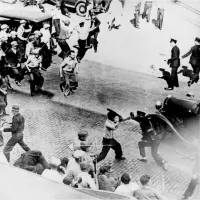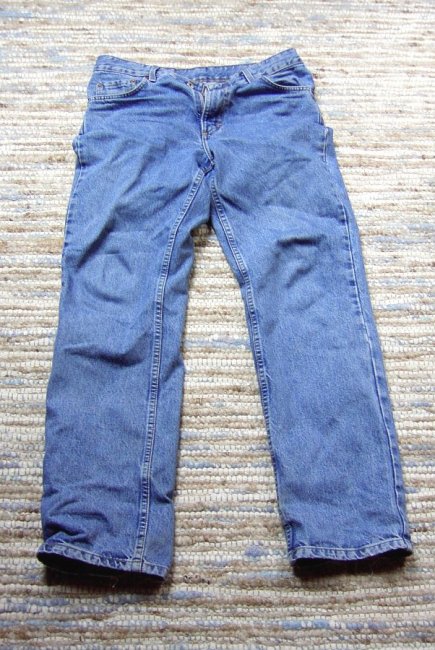Jeans are trousers typically made from denim or dungaree cloth. The term commonly refers to 'blue jeans,' a specific style featuring copper pocket rivets patented by Jacob W. Davis and Levi Strauss in 1873. However, the term 'blue jeans' predates the patent and was used for various garments made from blue denim.
1901: Levi Strauss adds back pocket to 501 model
In 1901, Levi Strauss added the back left pocket to their 501 model jeans, creating the industry-standard five-pocket configuration.
1935: Denim Distressing Appears in Vogue
In 1935, intentional denim distressing was seen as early as Vogue's June issue to make the product more fashionable.
1957: Introduction of Western-made jeans to the Soviet Union sparks "jeans fever"
During the 6th World Festival of Youth and Students in Moscow, Soviet Union in 1957, Western-made jeans were first introduced to the communist state, sparking "jeans fever."
1957: "Jeans fever" in the USSR started
In 1957, the "jeans fever" in the USSR started during the World Festival of Youth and Students.
1960: Levi Strauss flagship product still called waist overalls
Until 1960, Levi Strauss continued to call its flagship denim product "waist overalls" rather than "jeans", despite the growing popularity of jeans.
1961: Jeans were referred to as "worker's uniform"
According to a 1961 Soviet textile dictionary, jeans were initially referred to as a "worker's uniform".
1961: Smugglers Executed for Dealing in Jeans and Currency in Soviet Union
In 1961, two ringleaders, Y. T. Rokotov and V. P. Faibishenko, were caught and executed in the Soviet Union for smuggling foreign currencies and blue jeans, among other contraband, under Nikita Khrushchev's leadership.
1962: Levi Strauss Introduces Pre-Shrunk Jeans
In 1962, Levi Strauss introduced their own pre-shrunk jeans, known as the 505 regular fit jeans, following Lee and Wrangler, which prevented further shrinkage after purchase.
1965: Limbo Boutique Popularizes Washed Jeans
In 1965, Limbo, a boutique in New York's East Village, was the first retailer to wash new jeans to achieve a worn effect, and they also hired artists to embellish jeans with patches and decals, selling them for $200.
1977: Controversy in Japan over wearing jeans in classroom
In 1977, a professor at Osaka University in Japan, Philip Karl Pehda, criticized a female student for wearing jeans in the classroom, which led to protests and controversy.
Nov 1987: Sportswear International Magazine article on washed jeans
In Nov 1987, Sportswear International Magazine mentioned Limbo's washed jeans.
1992: Rape accusation in Italy involving tight jeans
In 1992, in Rome, Italy, a driving instructor was accused of rape after an incident during a driving lesson.
1998: Italian Supreme Court overturns rape conviction due to victim wearing tight jeans
In 1998, the Italian Supreme Court of Cassation overturned a rape conviction from 1992, arguing that because the victim was wearing tight jeans, she must have assisted in their removal, implying consensual sex.
2004: US consumers spend over $14 billion on jeans
In 2004, United States consumers spent more than US$14 billion on jeans.
2005: US consumers spend $15 billion on jeans
In 2005, United States consumers spent US$15 billion on jeans.
2008: Activewear purchases were 6% of teen apparel purchases
In 2008, activewear comprised 6% of teen apparel purchases, increasing to 28% in 2014.
2008: Italian Supreme Court of Cassation Overturns Denim Defense
In 2008, the Supreme Court of Cassation overturned the denim defense ruling, eliminating it as a legal defense in rape cases.
April 30, 2011: US consumers bought $13.8 billion of men's and women's jeans
In the year that ended April 30, 2011, US consumers purchased US$13.8 billion worth of men's and women's jeans.
2011: Denim Day officially recognized in at least 20 U.S. states
As of 2011, at least 20 U.S. states officially recognized Denim Day in April, where wearing jeans became an international symbol of protest against attitudes about sexual assault.
2014: Teens favor athleisure over denim
In 2014, teens were buying more fashion and athleisure clothing from brands like Nike and Lululemon, while denim sales decreased. Activewear comprised 28% of teen apparel purchases, up from 6% in 2008.
2015: Levi's sales decreased to $4.8 billion
In 2015, Levi's sales decreased from over US$7 billion to US$4.8 billion as they stuck to their core denim products instead of adapting to consumer trends.
2017: Low-rise jeans make a comeback
In 2017, media reported the trend of low-rise jeans, famous in the 1990s and 2000s, was coming back into fashion due to a sparked by an interest in Y2K style.
February 2021: Athleisure sales rise due to COVID-19 lockdowns
In February 2021, it was found that sales for athleisure had risen by 84% since March 2020 as a result of the COVID-19 lockdowns.
2021: Y2K Fashion and low-rise jeans make a comeback
In 2021, online searches for 'y2k fashion' had risen by 193%, showing that the fashion style was making a comeback, and low-rise jeans were becoming a common clothing item for teenagers and young adults.
Mentioned in this timeline
The United States of America is a federal republic located...
The Union of Soviet Socialist Republics USSR existed from to...
Japan is an East Asian island country situated in the...

A dictionary is a reference work containing lexemes from one...
Italy officially the Italian Republic is located in Southern and...

A supreme court the court of last resort in many...
Trending

24 days ago Deadly Ecuador Prison Riot: Dozens Dead and Injured in Inmate Clash

20 minutes ago Daniel Day-Lewis returns after eight-year retirement for 'Anemone,' captivating audiences again.

20 minutes ago Merab Dvalishvili focuses on today while Petr Yan downplays future title defenses.

20 minutes ago Daniel Radcliffe and Tom Felton Celebrate 24 Years Since 'Harry Potter' Debut.

2 months ago Brendan Fraser Credits 'Rental Family' for Helping Him Overcome Insecurities, Finds Self-Worth

2 hours ago Ray J criticizes Jay-Z and Beyonce for allegedly ignoring Brandy on tour.
Popular
Aftyn Alyssa Behn is an American politician currently serving as...
Matt and Ross Duffer known as the Duffer Brothers are...

Lane Kiffin is an American football coach currently serving as...

XXXTentacion born Jahseh Dwayne Ricardo Onfroy was a controversial yet...

Stranger Things created by the Duffer Brothers is a popular...

William Franklin Graham III commonly known as Franklin Graham is...
